From the shadows of the underworld, a figure emerges, her pale skin stark against the darkness.
She is Hel: Norse goddess of death, the keeper of the dead, a Jotunn of darkness and despair, feared yet revered by all who know her name in Norse mythology.
From her cold and comfortless halls, she watches over the spirits of the wicked, condemned to a life of misery and regret. But Hel is more than just a keeper of the damned. She is more than just one of the simple ancient gods of death.
Some say that she delights in causing suffering and death, relishing the power that her position gives her over the lives of mortals.
Others claim that she is simply fulfilling her role as the guardian of the underworld, doing what is necessary to keep the balance between life and death.
Regardless of what she is, one thing is for sure: she has an exciting backstory.
And we will be checking all of it out.
READ MORE: Norse Gods and Goddesses: the Deities of Old Norse Mythology
Table of Contents
What Was Hel Known For?
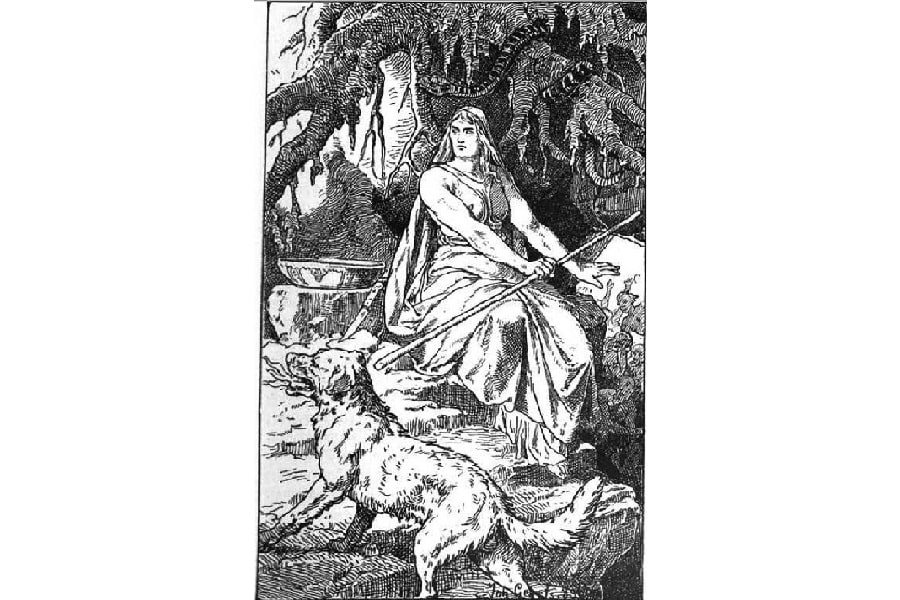
The goddess Hel in Norse mythology is associated with death and the underworld.
In Norse tradition, she is responsible for receiving the spirits of the deceased and taking them to the underworld, a realm called Helheim.
Her role coincides with Osiris’ role, who is in charge of the Duat (underworld) in Egyptian mythology.
And you got that one right; that’s exactly where she gets her name.
This realm is described as being located in the realm of Niflheim. It is said to be a place of great suffering and hardship, where the wicked are condemned to spend an eternity reflecting on the lives they have lived.
Despite her somber associations, Hel is sometimes portrayed as a guardian or protector of the dead and is responsible for taking the spirits of the deceased to the underworld to be judged.
READ MORE: 35 Ancient Egyptian Gods and Goddesses
Understanding Hel’s Position
Because of this gloomy goddess’s morbid, hellbent (pun intended) line of work, it is easy to see why Hel could potentially be viewed as an “evil” deity in Old Norse literature.
After all, she is associated with death and the underworld, typically seen as a malevolent force in many cultures.
But there’s a reason behind it.
The fact that she is responsible for taking the spirits of the wicked to a place of suffering and hardship could be interpreted as an act of punishment or vengeance, which might further contribute to her reputation as an “evil” goddess.
Was Hel Good or Evil?
It is important to note that “good” and “evil” are subjective and often shaped by cultural and personal values and beliefs.
In Norse mythology, death and the underworld are not necessarily seen as hostile forces.
In fact, they are an integral part of Norse cosmology. They are necessary for maintaining the balance between life and death. In this sense, Hel might be seen as a neutral or even positive figure, as she is fulfilling an essential role in the Norse worldview.
Furthermore, it is worth considering that the Norse gods and goddesses, including Hel, are often depicted as complex and multifaceted characters who exhibit both positive and negative qualities.
While Hel might be associated with death and suffering, she is also sometimes portrayed as a guardian or protector of the dead. She is responsible for taking the spirits of the deceased to the underworld to be judged.
In this role, she is sometimes depicted as a figure of authority with the power to determine the fates of the spirits in her care.
It is challenging to categorize Hel as either “good” or “evil” in Norse mythology, as she has both positive and negative characteristics.
Ultimately, the perception of Hel depends on the context and interpretation of the myths in which she appears.
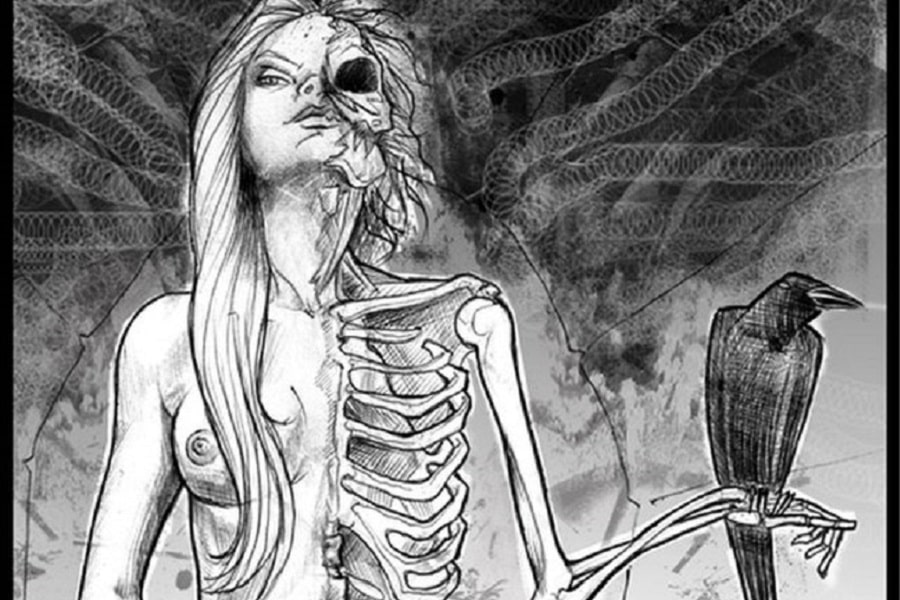
Is It Hel or Hela in Norse Mythology?
So wait, was MCU wrong after all? Is she called Hel instead of Hela?
Well, It’s not unusual for names to be spelled or pronounced differently in different languages or cultures. In Norse mythology, the correct spelling of the name of the goddess of death and the underworld is “Hel.”
However, some people might spell the name as “Hela,” perhaps due to misunderstandings or differences in pronunciation. Also, the Marvel Cinematic Universe references Hel as Hela, which might have caused a bit of a misconception for the greater public.
But here’s what you need to know.
“Hela” is not a recognized alternative spelling of the name, and there is no evidence to suggest that it is connected to the Norse goddess Hel in any way.
What Were Goddess Hel’s Powers?
Just as other Norse deities such as Freyr, Vidar, and Baldr look over things such as fertility, vengeance, and light, Hel rules over the underworld. Her abilities and powers reflect precisely that.
Here are some of them:
Some of her most notable powers include:
- Control over the realms of the dead: Hel is the boss of the underworld and has the power to decide who gets to hang out in her super chill ghost lounge or who has to stay in the “time out” room forever. So be on your best behavior, or you might end up in the “naughty” corner of the underworld.
- Power over life and death: Hel holds the keys to life and death itself as the gatekeeper of the afterlife. She can grant or revoke the gift of life, ensuring that the balance between the living and the dead is always maintained.
- Shapeshifting abilities: Hel is a master of disguise! She can shapeshift into any form, whether a majestic eagle or a sly fox. Some say she’s even been spotted as a funky disco ball at Norse mythology-themed dance parties.
Her shapeshifting talents aren’t explicitly mentioned in Norse tales. Instead, this ability to transform reflects Hel’s complex nature and ability to adapt to different situations rather than actual shapeshifting powers.
Just don’t make her angry, or she might turn into a giant, fire-breathing dragon (just kidding, we don’t think that form is in her repertoire).
Just don’t get on her wrong side, or you might find yourself six feet under before you know it!
In the Name
To understand Hel’s purpose in the pages of Old Norse literature, we must look at the literal meaning of her name.
The name “Hel” is derived from the Old Norse word “hel,” which means “hidden” or “concealed.” This name refers to the fact that an underworld is a place hidden from the mortal world and only accessible to the dead.
The name “Hel” also has connotations of illness and death, as it is related to words in Germanic etymology that mean “to harm” or “to kill.” This reflects the role of Hel as the keeper of the dead and her association with the end of life.
Here’s a more psychological take on her name if you are feeling thoughtful:
The idea of the underworld being hidden or concealed could be seen as a metaphor for the unknown and the unknowable. It represents the mysteries of death and the afterlife and the limitations of human understanding.
The fact that it is only accessible to the dead could be seen as a reflection of the finality of death and the fact that it marks the end of one’s earthly existence.
On a deeper level, the name “Hel” could also be seen as a symbol of the human fear of death and the unknown. It represents the uncertainty and anxiety surrounding the end of life and the desire to understand and make sense of it.
In this way, the name “Hel” reminds us of the inherent mystery and complexity of death and the afterlife and how it shapes our understanding of the world and our place.
Meet the Family
Hel was the daughter of Loki, the OG trickster god, and the giantess Angrboda.
This made her the sister of the wolf Fenrir and the world serpent Jörmungandr. Both of her siblings are due to play an immense role during Ragnarok, the twilight of the gods.
However, they all exist in different parts of the world. They have little to no correlation to each other besides their bloodline.
Imagine a family reunion between them.
Due to her being a rather omnipresent underworld realm entity, she can be associated with grave personalities in the world of Norse mythology. She was also the sister of Sigyn, sometimes known as Loki’s partner, and the aunt of Narfi and Váli.
On top of all that, she was also sometimes associated with the giant Thiassi, who was turned into an eagle by Thor and later killed by him.
Wow, that’s a lot of family drama! But don’t worry; you don’t have to be a Norse mythology expert to keep up with all these complicated relationships.
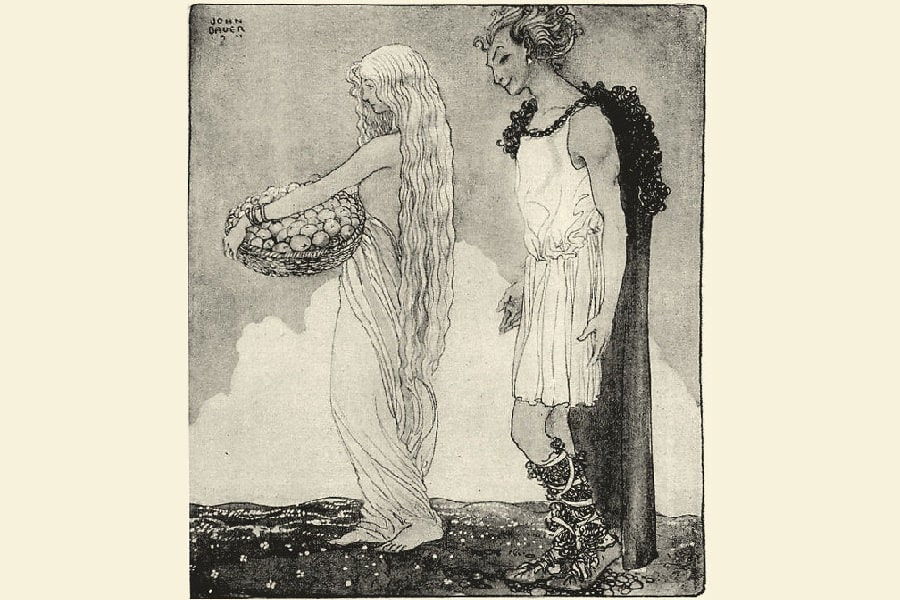
What Did Hel Look Like?
Hel’s appearance is her office attire, representing the grim nature of her work.
Hel is often depicted as a figure of great beauty, with long, flowing hair and a pale, ghostly complexion. She is sometimes described as half-flesh colored and half-blue, with one side of her face and body pale and the other dark. This dual nature is thought to reflect the two aspects of her character: her role as the goddess of death and her role as the guardian of the dead.
Despite her beauty, Hel is often depicted as cold and distant, with a heart of ice. She was also described as “downcast” and “fierce-looking.”
Hel is sometimes depicted as having beautiful, dark hair, often described as thick and tangled, in contrast to the decaying and horrid lower torso. This is thought to represent the chaotic and disordered nature of the underworld, which is a place of turmoil and suffering.
Overall, Hel’s appearance is often associated with death and decay and is meant to evoke feelings of fear and unease. However, it is essential to note that how Hel is depicted can vary greatly depending on the myth or source in which she appears.
Hel’s Symbols
Like many other goddesses across the world’s pantheons, Hel is often associated with certain symbols that reflect her role as the goddess of death and the underworld.
Some of these symbols include:
- A hound or dog: Dogs are associated with Hel in Norse mythology because they are symbols of loyalty, protection, and the guarding of the home. These are all passive qualities that Hel holds.
- A spindle: Spindles symbolize spinning the thread of life and death. This could’ve touched on the idea that Hel is responsible for maintaining the balance between life and death and has the power to end the lives of the living or restore the dead to life.
- A serpent or dragon: The serpent symbolizes rebirth because it sheds its skin and is reborn. It also makes sense to be one of her symbols as she is the sister of the world serpent, Jormungandr.
- A sickle: The sickle is a symbol that could’ve been associated with Hel, and it is believed to represent the end or cutting of the thread of life and death. This, just like the spindle, reflects Hel’s power to bring an end to the lives of the living or restore the dead to life.
Odin Exiles Hel
Being the sibling of an earth-wrapping serpent and a monstrous wolf’s sister has its cons. The fact that Hel was Loki’s child didn’t particularly help either.
Of course, we are talking about Odin keeping a close eye on Loki’s offspring.
The gods of Asgard, including Odin, were given a prophecy that the children of Loki, including Hel, would grow up to be a threat to them. In response to this, Odin either sent someone to retrieve the children or rode to Jotunheim to bring them back to Asgard. This was done so that Odin could keep an eye on the children and make sure that they did not cause any harm or disturbance to the gods.
The decision to bring Hel and her siblings to Asgard was motivated by a desire to protect the gods from the potential dangers that they posed.
This is precisely where the tales first mention Hel in the 13th-century Gylfaginning in the Prose Edda.
To ensure maximum protection, Odin divided each of the three siblings and put them in separate parts of the world: Jormungandr deep inside the sea, Fenrir in the cages of Asgard, and Hel in the dark underworld,
In doing so, Odin exiles Hel to the icy realm of Niflheim and gives her the power to rule over it. However, this power only extends to the souls of the deceased who will travel the road of the dead.
And that is how Hel came to be.
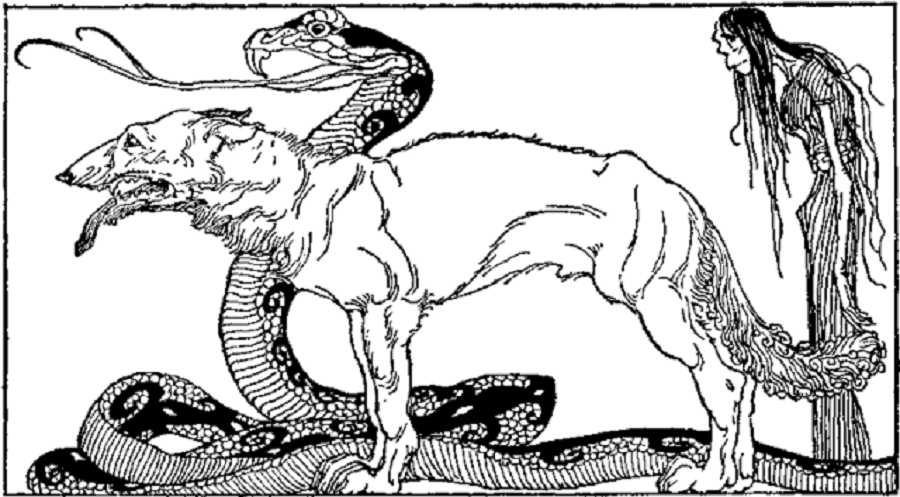
Inside Hel’s Realm
Time for a house tour.
The realm Hel resides in is mentioned in the Poetic Edda. In the poem “Grimnismal,” her abode is under the world tree Yggdrasil .”It is separated from the world of the living by a river full of weapons lost in war, such as spears and knives.
After one crosses this bridge of absurdity, they would finally enter Hel.
The realm of Hel is sometimes described as being divided into two parts: Niflhel, which is a place of punishment and misery for the wicked, and Helheim, which is a place of rest for those who were not dishonorable in life.
The Halls of Goddess Hel
The main hall where Hel herself resides is actually called “Eljudnir,” which literally translates to “damp with rain.”
Eljudnir is not like Valhalla, so it’s definitely the place you don’t want to go to when you die. It’s like the polar opposite of paradise, with snow, ice, and misery as far as the eye can see. The spirits of the dead are doomed to hang out here for eternity, and its immense gates are guarded by a giant, ferocious dog named Garm.
And guess what? Hel’s hall is also flanked by extremely high walls, so trespassing isn’t all that ideal.
Rudolf Simek, in the “Dictionary of Northern Mythology,” states:
“Her hall is called Eljudnir ‘the damp place’, her plate and her knife ‘hunger’, her servant Ganglati ‘the slow one‘, the serving maid Ganglot ‘the lazy one’, the threshold Fallandaforad ‘stumbling block’, the bed Kor ‘illness’, the bed curtains Blikjanda-bolr ‘bleak misfortune’.”
But even though Eljudnir seems to be a place of eternal despair, souls are said to be treated well there. This is seen in the myth of Baldr’s death and how he was warmly welcomed in this surreal afterlife hall.
Overall, Eljudnir is a bummer of a place and represents the end of life and all that jazz.
So, try not to go there unless you are crushing on Hel.
Baldr’s Death and Hel
The Death of Baldr
It was a sad day in Asgard, the realm of the gods, when the beloved Baldr, god of light, beauty, and peace, met his untimely demise.
His mother, Frigg, queen of the gods, became so worried about her son’s fate that she went to great lengths to protect him, extracting a promise from all the plants, animals, and elements of the earth that they would never harm Baldr.
But alas, fate had other plans.
Loki, ever the troublemaker, turned a sprig of mistletoe into a deadly dart and tricked the blind god Höðr into throwing it at a dying Baldr.
And just like that, Baldr was no more.
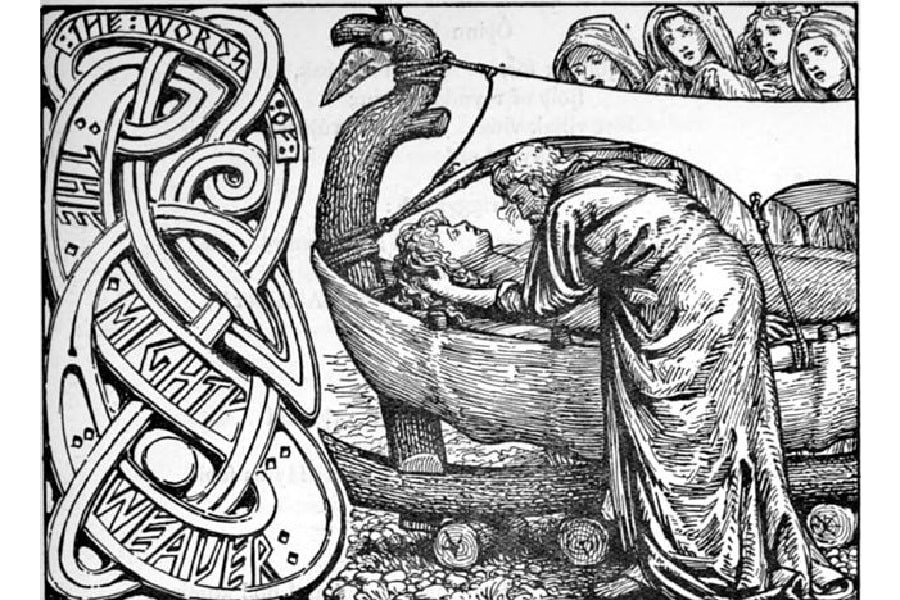
Hel Negotiates
The gods were devastated, and Frigg wept tears of gold.
Desperate for a way to bring Baldr back from the underworld, they decided to send a messenger to the realm of Hel to plead for his return.
Hel agreed to release Baldr, but with a catch: all the creatures in the nine worlds, including the dead, had to weep for him. If anyone refused, Baldr would have to remain in the underworld. Forever.
The gods sent messengers to every single corner of the nine worlds, and everyone agreed to weep for Baldr.
Or so they thought.
When the messengers returned to the underworld, the Gods expected Baldr’s immediate release. Instead, they found that one being had not wept: a giantess called Thokk (stylized as Þökk), actually Loki in disguise.
Enraged by the lack of tears, Hel shut down her proposal and doomed Baldr to stay in her realm until Ragnarok finally arrived.
Turns out dead Baldr would remain dead after all.
Hel and Ragnarok
Ragnarok is the ultimate party of the year! It’s the end of the world as we know it and the beginning of a new one.
And who doesn’t love a fresh start?
Hel is sure to be the life of the party during Ragnarok. Some say she’ll be leading an epic dance battle against the god with an army of the dead called the “Garmr-troop,” and it’s filled with all the cool spirits who have passed through the underworld.
But don’t worry if dancing isn’t your thing; Hel will also be hanging out on the sidelines, cheering on her father, Loki, as he fights his epic battle with Heimdall during the destruction and rebuilding of the world.
Either way, she will be the center of attention, being the guardian of the underworld and keeper of the spirits of the dead.
Hel’s Death in Ragnarok
Though Hel is not destined to die in Ragnarok, the goddess of the underworld is sure to get affected by it.
If she doesn’t survive Ragnarok, it will be so thanks to the world fire dispatched by Surtr, the fire Jotunn, scorching reality.
However, if she survives Ragnarok, Hel will continue to be the shepherd of lost souls and continue her business of taking care of the underworld.
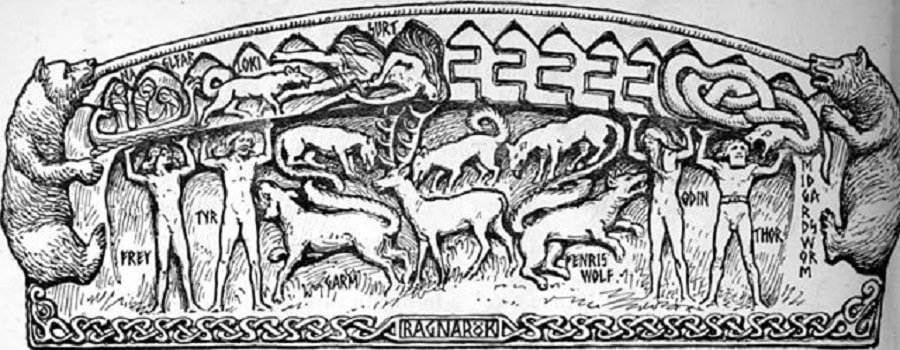
Hel in Other Cultures
The idea of a ghostly deity lurking in the roots of the world and guiding souls to their ultimate abode isn’t all that rare.
Here are some of Hel’s colleagues in other pantheons:
- Hades, the Greek god of the underworld, is similar to Hel in that both are responsible for the realm of the dead and are often depicted as dark, gloomy, and somber.
- Anubis, the Egyptian god of death and funerary rites. Anubis is often depicted as a jackal-headed deity who guides the souls of the dead to the underworld.
- Persephone, the Greek goddess of the underworld. Persephone is often depicted as a beautiful young woman who is sometimes associated with the changing of the seasons, as she spends part of the year in the underworld and part of the year above ground.
- Hecate: the Greek goddess of witchcraft. She is associated with liminal spaces and dark magic. She kept watch over the crossroads of reality and is a somewhat supernatural deity.
- Mictlantecuhtli, the Aztec god of death, is similar to Hel in that both are associated with death and the underworld. Mictlantecuhtli is often depicted as a skeleton-like deity, sometimes associated with the afterlife and the souls of the dead.
READ MORE: Aztec Mythology: Important Stories and Characters
Hel as the Underworld
When the Norse people used to think of Hel, it wasn’t always about the goddess.
In fact, the idea of a Norse Hel was referred exclusively to the dark underworld when mentioned in casual conversation.
The Norse people had a pretty twisted sense of humor, as they believed that after you die, you get to go on a little field trip through the underworld.
But don’t get too excited, because once you get there, you will be judged like a contestant on “American Idol.” If you were a good person, you get to go to Valhalla and party with the gods until the world’s end.
If you were a total loser, you get to spend eternity in the underworld, where it’s a never-ending root canal. But the underworld wasn’t all bad, as it was also seen as a place of great power and mystery.
You could become a superhero if you were brave enough to venture down there and come back alive.
Hel: Norse Goddess of Death in Pop Culture
Hel loves to make cameos in pop culture as the queen of the creepy underworld and death, often in varied interpretations and adaptations.
You can find her in Marvel Comics as Hela, the goddess of death and ruler of the realm of the dead.
Or, if you’re into video games, try Sony’s “God of War: Ragnarok,” where the main character Kratos gracefully travels through Hel. She is also featured in the popular MOBA “Smite,”
She’s also popped up in TV shows like Supernatural and movies like Thor: Ragnarok, where she’s depicted as a menacing figure of death with a Hollywood-esque purpose of ending the world no matter what.
In literature, Hel can be found in works like Neil Gaiman’s “American Gods,” where she’s a mysterious figure ruling over the land of the dead, doing justice to her original personality in Norse myths.
Wrapping it up, Hel is a big deal in pop culture as the symbol of death, the underworld, and the world’s end.
Conclusion
Hel, the Norse goddess of death
Ruling Niflheim with an icy breath
Where the souls of the dead, she does keep
Until the end of time, in her realm, they’ll sleep.
References
“The Role of Hel in Norse Mythology” by Karen Bek-Pedersen, published in The Journal of English and Germanic Philology.
“The Prose Edda: Norse Mythology” by Snorri Sturluson, translated by Jesse L. Byock
https://www.sacred-texts.com/neu/pre/pre04.htm
“Death, Female Cults and the Aesir: Studies in Scandinavian Mythology” by Barbara S. Ehrlich”
The Poetic Edda: Essays on Old Norse Mythology” edited by Paul Acker and Carolyne Larrington